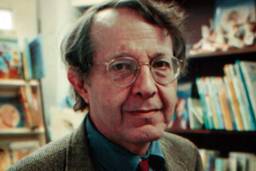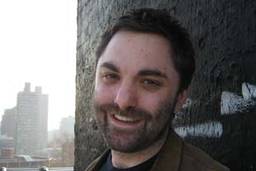Last spring, Chris Hedges, the Pulitzer Prize-winning former foreign correspondent for the New York Times, flew to California to see some atheists about God. Over the course of two debates – one in Los Angeles, the other in Berkeley – Hedges sparred with Sam Harris, author of The End of Faith, and Christopher Hitchens, author of God Is Not Great. According to Aneli Rufus, who reported on the Hedges vs. Hitchens debate for AlterNet, Hedges was “trounced.”
Atheism 2, God 0.
Now, out of these debates comes Hedges’ latest book, I Don’t Believe In Atheists (Free Press, 2008), a relentless, deeply considered defense of the religious impulse.
The book’s title is neither an accurate personal statement nor a reflection of the volume’s contents. As Hedges has said, he is no atheist. Nevertheless, he eloquently defends atheists who are “intellectually honest” – those “who accept an irredeemable and flawed human nature” – and believes “they hold an honored place in a pluralistic and diverse community.” Intended to provoke, the title sets up false expectations for a simplistic “no atheists in foxholes” screed that sells the book short.
Instead, Hedges’ main target is utopia, which he calls “the most dangerous legacy of the Christian faith and Enlightenment.” And primarily in the works of evolutionary biologist and author Richard Dawkins, as well as Hitchens and Harris – the “new atheists,” as Hedges calls them – the author finds a morally bankrupt utopian worldview that divides humanity between the primitive faithful and the civilized rational.
According to Hedges, the new atheists argue that once humanity is delivered from religion – what Hitchens has called “man-made filthy propaganda” – and places its faith in science and reason, we will finally advance morally as a species. But “hidden under the jargon of reason and science,” writes Hedges, this conviction is a secular version of religious extremism. To Hedges, this makes them dangerous.
“Too many of the new atheists, like the Christian fundamentalists, support the imperialist projects and pre-emptive wars of the United States as necessities in the battle against terrorism and irrational religion,” he writes. To make his case, he cites Harris’ justification for a nuclear first-strike on the Middle East and Hitchens’ continued support for democracy-via-bombing in Iraq.
Hedges doesn’t mince words about these atheists: They are “suburban mutations,” “hopeless epicures” and “products of the morally stunted world of entertainment.” Because many atheists conflate radical, literalist religion with all religion – and refuse to see any good that has come from faith – Hedges sees them as intellectually shallow. To him, one must come at faith honestly – through years of sustained thought, reading, reflection and introspection. The same goes for atheism.
One of the strengths of Atheists is Hedges’ authority to write on the topic. The son of a Presbyterian minister, he witnessed how his father’s faith inspired him to fight for social justice, even when it was deeply unpopular in the rural, upstate New York communities in which he preached. It was this model of courage-through-faith that led Hedges to pursue a degree from Harvard’s Divinity School, where he gained his understanding of theology.
Hedges spent the next 20 years covering foreign wars for a host of newspapers, including the Times, where he served as the Middle East Bureau Chief. He has witnessed many of the late 20th century’s worst horrors – in Algeria, Bosnia, El Salvador, Iraq, Kosovo and Sudan (where he was imprisoned). Hedges mined these experiences to great effect in his excellent, hard-hitting 2003 book, War Is A Force That Gives Us Meaning.
In a 2008 interview with Salon, Hedges said, “I spent so long in war zones that I think we don’t know what we would do under repression and abuse. … That’s the brilliance of the great writers on the Holocaust, like Primo Levi. … They understood the humanity of their own killers.”
Hedges spends the first half of Atheists refuting the claim that humanity has advanced morally. “The Enlightenment myth … taught that our physical and social environment could be transformed through rational manipulation. … [But] human history is not a long chronicle of human advancement. It includes our cruelty, barbarism, reverses, blunders and self-inflicted disasters.”
In the second chapter, “God and Science,” Hedges provides an engrossing history of Darwinism and the Enlightenment, and their dark legacies of violence. He cites Friedrich Nietzsche’s fear that the British would use social Darwinism to justify imperialism, and offers a pellucid argument against science’s application to philosophy.
Hedges understands the depravity of which human beings are capable – be they secular or religious. “To turn away from God is harmless. To turn away from sin is catastrophic,” he writes.
At the same time, we all experience moments of transcendence – such as a parent’s love for his child – that we are driven to account for. The meaning of this contradiction is the domain of religion. Science can never adequately grapple with such subjective human complexity:
Scientific ideas … are embraced or rejected on the basis of quantifiable evidence. But human relationships and social organizations interact and function effectively when they are not rigid, when they accept moral ambiguity, and when they take into account the irrational.
Hedges draws from the works of artists like Samuel Beckett, Albert Camus, Willa Cather, Joseph Conrad, Fyodor Dostoevsky and Uta Hagen, as well as figures like Thomas Aquinas, Sigmund Freud, Reinhold Niebuhr and Arthur Schopenhauer. These individuals, who wrestled with – and against – faith and a tragic worldview, serve as Hedges’ touchstones as he seeks to express the core limits of humanity and what he calls “the possibilities of religion.”
Hedges’ writing has a hurtling, runneth-over quality that can be redundant and vague at times (as in his section on the concept of “tempered free will”). He is also prone to cranky digressions (as in his section on a fashion designer profiled on CNN). And some readers may be disappointed to find that Hedges does not systematically dismantle each argument in the new atheists’ books.
Instead, Hedges views the new atheists not so much as an organized threat, but as indicators of a larger tendency in America toward a dangerously simplistic way of thinking. “It is fear, ignorance, a lack of introspection and the illusion that we can create a harmonious world that leads us to sanction the immoral,” Hedges writes. “Our enemies have no monopoly on sin, nor have we one on virtue.”
Hedges proposes the radical notions that we admit our complicity in the violence of the world and acknowledge the humanity of our enemies. Religion – with its other long history of encouraging compassion toward others and introspection about the evil at the center of humanity’s heart – is too valuable in this aim to be flatly dismissed. Amen.








